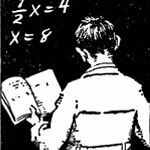Philosophy and Fun of Algebra
by Mary Everest Boole

Philosophy and Fun of Algebra is meant for young readers as an introduction to the basics of algebra and logic. Her style is humorous, easy to read, and conversational.
Source: Boole, M. E. (1909). Philosophy and Fun of Algebra.London, England:.
- "Basil and Margaret"
- The author introduces her work with a short fable.
- Chapter 1: "From Arithmetic to Algebra"
- The journey from understanding arithmetic and the laws of logos to understanding algebra is explained, in a way suitable for children.
- Chapter 2: "The Making of Algebras"
- The author explains that anything can be algebra, using the example of teaching a baby to think algebraically.
- Chapter 3: "Simultaneous Problems"
- An explanation that algebra involves educated hypotheses in order to work towards understanding the solutions to problems.
- Chapter 4: "Partial Solutions and the Provisional Elimination of Elements of Complexity"
- The problems of limiting elements and still leaving minds open to all possibilites.
- Chapter 5: "Mathematical Certainty and Reductio ad Absurdum"
- The author explains to benefit of embracing reductio ad absurdum.
- Chapter 6: "The First Hebrew Algebra"
- A brief history of Hebrew algebra.
- Chapter 7: "How to Choose Our Hypothesis"
- Some tips on how to form a mathematical hypothesis.
- Chapter 8: "The Limits of the Teacher's Function"
- Discusses the role of logic in the teaching and learning of Hebrew algebra.
- Chapter 9: "The Use of Sewing Cards"
- A description of the Boole method for learning algebra.
- Chapter 10: "The Story of a Working Hypothesis"
- "In an old Hebrew book there is a story of a person named Jacob, which means the Supplanter..."
- Chapter 11: "Macbeth's Mistake"
- "The whole question of choosing one’s next working hypothesis has been fogged, owing to people’s neglect of a very simple principle..."
- Chapter 12: "Jacob's Ladder"
- "In Chapter X. I set you children a question:—Why did Jacob’s angels come down a ladder, whereas other Hebrews saw angels mixed up with romantic pretty things such as wings and clouds?..."
- Chapter 13: "The Great 'x' of the World"
- "A great question which people like to quarrel about is:—Who or What made things be as they are?"
- Chapter 14: "Go to My Class-Room"
- "A story is told of one of the orderly pupils of Mosaism who got to know a good deal about weather and electricity; and at last he got out of patience with the people who wanted to shout and argue..."
- Chapter 15: "The Square Root of Minus One"
- The author shows the risk in forgetting to allow for what we do not know.
- Chapter 16: "Infinity"
- "You remember the angel who looks like this, √-1..."
- Chapter 17: "From Bondage to Freedom"
- "Moses had said, from the first, that the people of Israel would have to think of “I Am” as the deliverer from bondage; but they were not, at the time when he said it, advanced enough in their algebra to understand that idea properly..."
- Chapter 18: Appendix
- "The essential element of Algebra:—the habitual registration of the exact limits of one’s knowledge, the incessant calling into consciousness of the fact of one’s own ignorance, is the element which Boole’s would-be interpreters have left out of his method..."
- Year Published: 1909
- Language: English
- Country of Origin: England
-
Readability:
- Flesch–Kincaid Level: 6.0
- Word Count: 14,395
- Genre: Informational
- Keywords: math history, mathematics